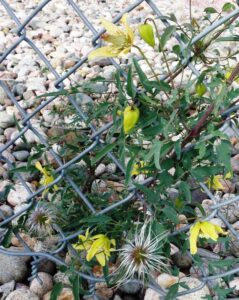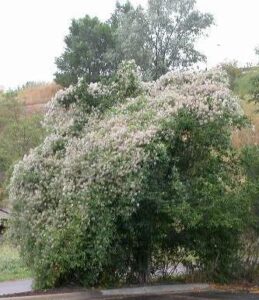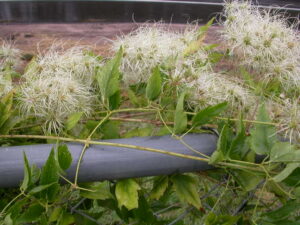Chinese clematis
Clematis orientalis
Chinese clematis, native to Asia, is a Colorado Noxious Weed List B species. This species is a perennial, herbaceous to woody vine with solitary flowers that have four yellow sepals. It flowers late in the season on new wood. The seedheads that it produces are long tailed and feathery. Seedheads are conspicuous all winter.
Chinese clematis prefers a variety of habitats including riverbanks, riparian forests, scrub gullies, and slopes in hot dry valleys, especially on rocks by rivers and in scrub to 8500 feet in elevation.
Leaves are opposite, pinnately compound and have 5 to 7 leaflets. The vine climbs vigorously by petioles and rapidly overgrows trees, shrubs and other native species, ultimately killing them. Growth rate is 3 feet plus per year.
Some, if not all members of this genus are mildly poisonous to humans and livestock. All plant parts of Chinese clematis are toxic to humans, dogs, cats and horses. This species causes severe burning sensation and ulcers of the mouth.
The listing of this species as a noxious weed includes all of the Clematis orientalis subspecies as well as any named cultivars. Chinese clematis has been reported for sale as Clematis orientalis ‘Bill MacKenzie’.
Flower color, and bloom dates are distinguishing features of Chinese clematis helping to separate it from the species native to Colorado. Native Clematis species bear many more flowers on their petioles than Chinese clematis’ solitary flowers. Western Virgins Bower (Clematis ligusticifolia) has white sepals while Blue clematis (Clematis occidentalis) has light blue-lavender sepals. Rocky Mountain clematis (Clematis columbiana) also bears light blue-lavender sepals, yet Sugarbowls (Clematis hirsutissima), a bushy plant, has brownish-purple sepals. Bloom dates help with the separation of species since Chinese clematis flowers can last well into October while the native species bloom from late April through August.
Good plant identification skills are required to discern the native Clematis from Chinese clematis especially when the native species are at the end of their floral phase for the season.





